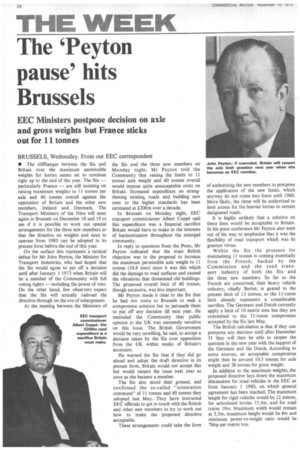The 'Peyton pause' hits Brussels
Page 30

If you've noticed an error in this article please click here to report it so we can fix it.
EEC Ministers postpone decision on axle and gross weights but France sticks out for 11 tonnes
BRUSSELS, Wednesday. From our EEC correspondent
• The cliffhanger between the Six and Britain over the maximum permissible weights for lorries seems set to continue right up to the end of the year. The Six — particularly France — are still insisting on raising maximum weights to Il tonnes per axle and 40 tonnes overall against the opposition of Britain and the other new members, Ireland and Denmark. The Transport Ministers of the Nine will meet again in Brussels on December 18 and 19 to see if it is possible to work out special arrangements for the three new members so that the directive on weights and sizes to operate from 1980 can be adopted in its present form before the end of this year.
On the surface this represents a tactical defeat for Mr John Peyton, the Minister for Transport Industries, who had hoped that the Six would agree to put off a decision until after January 1 1973 when Britain will be a member of the Community with full voting rights — including the power of veto. On the other hand, few observers expect that the Six will actually railroad the directive through on the eve of enlargement.
At the meeting between the Ministers of the Six and the three new members on Monday night, Mr Peyton told the Community that raising the limits to 11 tonnes axle weight and 40 tonnes overall would impose quite unacceptable costs on Britain. Increased expenditure on strengthening existin roads and building new ones to the higher standards has been estimated at £200m over a decade.
In Brussels on Monday night, EEC transport commissioner Albert Copp e said this expenditure was a financial sacrifice Britain would have to make in the interests of harmonization throughout the enlarged community.
In reply to questions from the Press, Mr Peyton indicated that the main British objection was to the proposal to increase the maximum permissible axle weight to 11 tonnes (10.8 tons) since it was this which did the damage to road surfaces and caused the vibrations that threatened old buildings. The proposed overall limit of 40 tonnes, though excessive, was less important.
Mr Peyton made it clear to the Six that he had not come to Brussels to seek a compromise solution but to persuade them to put off any decision till next year. He reminded the Community that public opinion in the UK was extremely sensitive on this issue. The British Government would be very unwilling, he said, to accept a decision taken by the Six over opposition from the UK within weeks of Britain's accession.
He warned the Six that if they did go ahead and adopt the draft directive in its present form, Britain would not accept this but would reopen the issue next year as soon as she became a member.
The Six also stood their ground, and confirmed the so-called "orientation commune" of 11 tonnes and 40 tonnes they adopted last May. They have instructed EEC officials to get in touch with the British and other new members to try to work out how to make the proposed directive acceptable.
These arrangements could take the form of authorizing the new members to postpone the application of the new limits, which anyway do not come into force until 1980. More likely, the three will be authorized to limit access for the heavier lorries to certain designated roads.
It is highly unlikely that a solution on these lines would be acceptable to Britain. In his press conference Mr Peyton also went out of his way to emphasize that it was the• flexibility of road transport which was its greatest virtue.
Within the Six the pressure for maintaining 11 tonnes is coming essentially from the French, backed by the Commission and the road transport industry of both the Six and the three new members. So far as the French are concerned, their heavy vehicle industry, chiefly Berliet, is geared to the present limit of 13 tonnes, so the 11-tonne limit already represents a considerable sacrifice. The Germans and Dutch currently apply a limit of 10 metric tons but they are committed to the 11-tonne compromise accepted by the Six last May.
The British calculation is that if they can postpone any decision until after December 31 they will then be able to reopen the question in the new year with the support of the Germans and the Dutch. According to some sources, an acceptable compromise might then be around 10.5 tonnes for axle weight and 38 tonnes for gross weight.
In addition to the maximum weights, the proposed directive lays down the maximum dimensions for road vehicles in the EEC as from January 1 1980, on which general agreement has been reached. The maximum length for rigid vehicles would be 12 metres, for articulated lorries 15.5m, and for road trains 18m. Maximum width would remain at 2.5m, maximum height would be 4m and minimum power-to-weight ratio would be 7bhp per metric ton.




































































































































